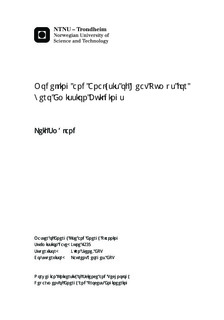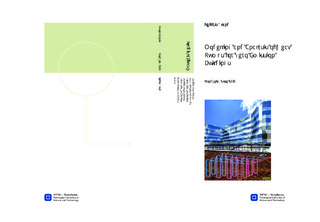| dc.description.abstract | The work of this Master thesis is a continuation of a project work. This defines qualitative and quantitative parameters needed to make a simulation tool for early-stage decision making with regards to the energy supply strategy for non-residential Zero Emission Building (ZEB). The work is based on the assumption that the heat pump (HP) technology will be one of the core technologies for the energy supply strategy in the ZEB concept. The simulation tool proposed should be able to find the best energy supply strategy for the building, and its design parameters. It is believed that the design parameters for the energy supply strategy are different for ZEB than for standard building concepts, both when it comes to the optimal HP power coverage factor factor and preferred energy supply strategy (combination of technologies).In this Master thesis, the algorithm and methodology behind a Beta-version simulation tool, similar to that proposed in the project report, is presented. The recommended energy supply strategy is determined based on technical-economic considerations. The explanation of the algorithm and methodology is followed by a proof of concept, where the simulation tool is tested on a benchmark office building. This is to check whether ZEBs have different design characteristics compared to other building concepts. As the simulation tool also can be use on different building standards, e.g. TEK10 and passive buildings, this can be verified.Through the first part of the thesis, the algorithm and methodology used to obtain the design characteristics for the energy supply system are presented. Various delimitations and simplifications are made, some being different than the concept proposed in the project report. The input parameters needed to perform the calculations are somewhat inaccurate, as the time to acquire them was limited. The original scope of the simulation tool presented in the project report would be to comprehensive for the Master thesis.Further, the benchmark building is presented and simulations on a TEK10, passive and ZEB are performed. To see if the simulation tool gives valid results, the outputs found for the TEK10 building are tested against some pre-defined expected range of results. These are reached, so that it is believed that the Beta-version simulation tool gives plausible output. Generally the energy supply strategies with low investment costs perform best, which are also the most CO2-emission intensive solutions.The findings for the passive office version of the benchmark building are also likely to be valid. Lower annual costs for the energy supply systems are found and particularly the operational costs, which are expected for a building with a more energy efficient envelope. It is also found that a lower HP power coverage factor is required to obtain a large energy coverage, and its physical interpretation is given.The ZEB building must counterbalance all CO2-emissions associated for operation of (here) the HVAC and domestic hot water (DHW) systems. As expected, for the ZEB office, the energy supply strategy design parameters have changed drastically. The cost optimal energy supply for the TEK10 and the passive office were relatively CO2-intensive, which is disadvantageous if these emissions would have to be counterbalanced. In general, the less CO2-intensive systems are the preferred ones to reach the ZEB balance. While for the more CO2-intensive alternatives, the optimum HP power coverage factor has gone up leading to higher energy coverage and thus less CO2-emissions.The results found in this thesis have a large degree of uncertainty. Their tendency should therefore only be seen as indications. However, also through a sensitivity analysis of the output, the simulation tool proves to perform as wanted and to give plausible results. The output is therefore considered as an acceptable proof of concept of the algorithm and methodology which could be used in a more advanced version of the simulation tool. To have a well functioning full scale version, the simplifications implemented in the algorithm should be checked and the system solutions included should be analyzed and evaluated before implementation. | nb_NO |

